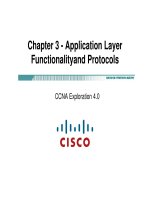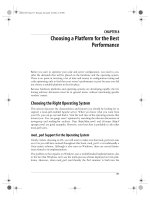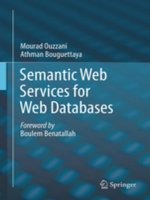A Semantic Web Primer - Chapter 0 docx
Bạn đang xem bản rút gọn của tài liệu. Xem và tải ngay bản đầy đủ của tài liệu tại đây (372.68 KB, 19 trang )
A Semantic Web Primer
Grigoris Antoniou and Frank van Harmelen
A Semantic Web Primer
Antoniou and van Harmelen
,!7IA2G2-abcbac!:t;K;k;K;k
0-262-01210-3
#737806 03/23/04
A Semantic Web Primer
Grigoris Antoniou and Frank van Harmelen
The development of the Semantic Web, with machine-readable content, has the potential to revolutionize the
World Wide Web and its use. In
A Semantic Web Primer
Grigoris Antoniou and Frank van Harmelen provide an
introduction and guide to this emerging field, describing its key ideas, languages, and technologies. Suitable
for use as a textbook or for self-study by professionals, the book concentrates on undergraduate-level funda-
mental concepts and techniques that will enable readers to proceed with building applications on their own
and includes exercises, project descriptions, and annotated references to relevant online materials.
A Semantic Web Primer
is the only available book on the Semantic Web to include a systematic treatment
of the different languages (XML, RDF, OWL, and rules) and technologies (explicit metadata, ontologies, and
logic and inference) that are central to Semantic Web development. The book also examines such crucial
related topics as ontology engineering and application scenarios. After an introductory chapter, topics covered
in succeeding chapters include XML and related technologies that support semantic interoperability; RDF
and RDF Schema, the standard data model for machine-processible semantics; and OWL, the W3C-approved
standard for a Web ontology language that is more extensive than RDF Schema; rules, both monotonic and
nonmonotonic, in the framework of the Semantic Web; selected application domains and how the Semantic
Web would benefit them; the development of ontology-based systems; and current debates on key issues and
predictions for the future.
Grigoris Antoniou is Professor at the Institute for Computer Science, FORTH (Foundation for Research and
Technology-Hellas), Heraklion, Greece. Frank van Harmelen is Professor in the Department of Artificial
Intelligence at the Vrije Universiteit, Amsterdam, the Netherlands.
Cooperative Information Systems series
“A book we have been waiting for: a concise yet detailed introduction to the basic concepts and methods for
the Semantic Web.”
—Rudi Studer, Institute AIFB, University of Karlsruhe, Germany
“This book is a great introduction to the Semantic Web and in particular to the new languages (RDF Schema
and OWL) that have recently become standard for it. I am using the book with my undergraduate Semantic
Web class, and the students find it well written and clear. For those who want to roll up their sleeves and
learn about this emerging technology, this book will be a powerful tool.”
—James Hendler, Professor, Computer Science Department, University of Maryland
“This is an excellent and much-needed book. It gives the reader a broad introduction to the motivation behind
the Semantic Web, as well as its applications and supporting technologies.”
—Ian Horrocks, Department of Computer Science, University of Manchester, United Kingdom
The MIT Press
Massachusetts Institute of Technology
Cambridge, Massachusetts 02142
MC737806front.qxd 5/20/04 9:16 AM Page 1
TLFeBOOK
TLFeBOOK
Cooperative Information Systems
Michael Papazoglou, Joachim W. Schmidt, and John Mylopoulos, editors
Advances in Object-Oriented Data Modeling
Michael P. Papazoglou, Stefano Spaccapietra, and Zahir Tari, editors, 2000
Workflow Management: Models, Methods, and Systems
Wil van der Aalst and Kees Max van Hee, 2002
A Semantic Web Primer
Grigoris Antoniou and Frank van Harmelen, 2004
TLFeBOOK
TLFeBOOK
A
Semantic
Web
Primer
Grigoris Antoniou
and
Frank van Harmelen
The MIT Press
Cambridge, Massachusetts
London, England
TLFeBOOK
TLFeBOOK
© 2004 Massachusetts Institute of Technology
All rights reserved. No part of this book may be reproduced in any form by any
electronic or mechanical means (including photocopying, recording, or information
storage and retrieval) without permission in writing from the publisher.
This book was set in 10/13 Palatino by the authors using L
A
T
E
X2
ε
.
Printed and bound in the United States of America.
Library of Congress Cataloging-in-Publication Data
Antoniou, G. (Grigoris)
A semantic Web primer/ Grigoris Antoniou and Frank van Harmelen.
p. cm.–(Cooperative information systems)
Includes bibliographical references and index.
ISBN 0-262-01210-3 (hc.: alk. paper)
1. Semantic Web. I. Van Harmelen, Frank. II. Title. III. Series.
TK5105.88815. A58 2004
025.04–dc22
2003065165
10987654321
TLFeBOOK
TLFeBOOK
Dedicated to Konstantina
G.A.
TLFeBOOK
TLFeBOOK
Brief Contents
1 The Semantic Web Vision 1
2 Structured Web Documents in XML 23
3 Describing Web Resources in RDF 61
4Web Ontology Language: OWL 109
5 Logic and Inference: Rules 151
6 Applications 179
7 Ontology Engineering 205
8 Conclusion and Outlook 223
A Abstract OWL Syntax 227
TLFeBOOK
TLFeBOOK
TLFeBOOK
TLFeBOOK
Contents
List of Figures xiii
Series Foreword xv
Preface xix
1 The Semantic Web Vision 1
1.1 Today’s Web 1
1.2 From Today’s Web to the Semantic Web: Examples 3
1.3 Semantic Web Technologies 7
1.4 A Layered Approach 16
1.5 Book Overview 19
1.6 Summary 19
Suggested Reading 20
2 Structured Web Documents in XML 23
2.1 Introduction 23
2.2 The XML Language 27
2.3 Structuring 31
2.4 Namespaces 43
2.5 Addressing and Querying XML Documents 45
2.6 Processing 49
2.7 Summary 55
Suggested Reading 57
Exercises and Projects 58
TLFeBOOK
TLFeBOOK
x Contents
3 Describing Web Resources in RDF 61
3.1 Introduction 61
3.2 RDF: Basic Ideas 63
3.3 RDF: XML-Based Syntax 69
3.4 RDF Schema: Basic Ideas 80
3.5 RDF Schema: The Language 84
3.6 RDF and RDF Schema in RDF Schema 91
3.7 An Axiomatic Semantics for RDF and RDF Schema 94
3.8 A Direct Inference System for RDF and RDFS 99
3.9 Querying in RQL 100
3.10 Summary 104
Suggested Reading 105
Exercises and Projects 106
4 Web Ontology Language: OWL 109
4.1 Introduction 109
4.2 The OWL Language 115
4.3 Examples 129
4.4 OWL in OWL 138
4.5 Future Extensions 144
4.6 Summary 146
Suggested Reading 146
Exercises and Projects 148
5 Logic and Inference: Rules 151
5.1 Introduction 151
5.2 Example of Monotonic Rules: Family Relationships 154
5.3 Monotonic Rules: Syntax 155
5.4 Monotonic Rules: Semantics 158
5.5 Nonmonotonic Rules: Motivation and Syntax 161
5.6 Example of Nonmonotonic Rules: Brokered Trade 163
5.7 Rule Markup in XML: Monotonic Rules 167
5.8 Rule Markup in XML: Nonmonotonic Rules 173
5.9 Summary 176
Suggested Reading 176
Exercises and Projects 177
TLFeBOOK
TLFeBOOK
Contents xi
6 Applications 179
6.1 Introduction 179
6.2 Horizontal Information Products at Elsevier 179
6.3 Data Integration at Audi 182
6.4 Skill Finding at Swiss Life 185
6.5 Think Tank Portal at EnerSearch 187
6.6 e-Learning 191
6.7 Web Services 194
6.8 Other Scenarios 199
Suggested Reading 201
7 Ontology Engineering 205
7.1 Introduction 205
7.2 Constructing Ontologies Manually 205
7.3 Reusing Existing Ontologies 209
7.4 Using Semiautomatic Methods 211
7.5 On-To-Knowledge Semantic Web Architecture 215
Suggested Reading 218
Project 218
8 Conclusion and Outlook 223
8.1 How It All Fits Together 223
8.2 Some Technical Questions 224
8.3 Predicting the Future 224
A Abstract OWL Syntax 227
Index 235
TLFeBOOK
TLFeBOOK
TLFeBOOK
TLFeBOOK
List of Figures
1.1 A hierarchy 11
1.2 Intelligent personal agents 15
1.3 A layered approach to the Semantic Web 18
2.1 Tree representation of an XML document 31
2.2 Tree representation of a library document 46
2.3 Tree representation of query 4 48
2.4 Tree representation of query 5 48
2.5 A template 52
2.6 XSLT as tree transformation 56
3.1 Graph representation of triple 65
3.2 A semantic net 65
3.3 Representation of a tertiary predicate 68
3.4 Representation of a tertiary predicate 78
3.5 A hierarchy of classes 82
3.6 RDF and RDFS layers 84
3.7 Subclass hierarchy of some modeling primitives of RDFS 87
3.8 Instance relationships of some modeling primitives of RDFS 87
3.9 Class hierarchy for the motor vehicles example 90
4.1 Subclass relationships between OWL and RDF/RDFS 115
4.2 Inverse properties 119
4.3 Classes and subclasses of the African wildlife ontology 129
4.4 Branches are parts of trees 129
4.5 Classes and subclasses of the printer ontology 133
TLFeBOOK
TLFeBOOK
xiv List of Figures
5.1 Monotonic rules DTD versus RuleML 172
6.1 Querying across data sources at Elsevier 181
6.2 Semantic map of part of the EnerSearch Web site 189
6.3 Semantic distance between EnerSearch authors 190
6.4 Browsing ontologically organized papers in Spectacle 191
6.5 Top level of the process ontology 198
7.1 Semantic Web knowledge management architecture 215
TLFeBOOK
TLFeBOOK
Series Foreword
The traditional view of information systems as tailor-made, cost-intensive
database applications is changing rapidly. The change is fueled partly by
a maturing software industry, which is making greater use of off-the-shelf
generic components and standard software solutions, and partly by the on-
slaught of the information revolution. In turn, this change has resulted in a
new set of demands for information services that are homogeneous in their
presentation and interaction patterns, open in their software architecture,
and global in their scope. The demands have come mostly from applica-
tion domains such as e-commerce and banking, manufacturing (including
the software industry itself), training, education, and environmental man-
agement, to mention just a few.
Future information systems will have to support smooth interaction with
a large variety of independent multi-vendor data sources and legacy applica-
tions, running on heterogeneous platforms and distributed information net-
works. Metadata will play a crucial role in describing the contents of such
data sources and in facilitating their integration.
As well, a greater variety of community-oriented interaction patterns will
have to be supported by next-generation information systems. Such inter-
actions may involve navigation, querying and retrieval, and will have to be
combined with personalized notification, annotation, and profiling mecha-
nisms. Such interactions will also have to be intelligently interfaced with
application software, and will need to be dynamically integrated into cus-
tomized and highly connected cooperative environments. Moreover, the
massive investments in information resources, by governments and busi-
nesses alike, call for specific measures that ensure security, privacy and ac-
curacy of their contents.
All these are challenges for the next generation of information systems.
We call such systems Cooperative Information Systems, and they are the focus
of this series.
TLFeBOOK
TLFeBOOK
xvi Series Foreword
In lay terms, cooperative information systems are servicing a diverse
mix of demands characterized by content—community—commerce. These de-
mands are originating in current trends for off-the-shelf software solutions,
such as enterprise resource planning and e-commerce systems.
A major challenge in building cooperative information systems is to de-
velop technologies that permit continuous enhancement and evolution of
current massive investments in information resources and systems. Such
technologies must offer an appropriate infrastructure that supports not only
development, but also evolution of software.
Early research results on cooperative information systems are becoming
the core technology for community-oriented information portals or gate-
ways. An information gateway provides a “one-stop-shopping” place for
a wide range of information resources and services, thereby creating a loyal
user community.
The research advances that will lead to cooperative information systems
will not come from any single research area within the field of Information
Technology. Database and knowledge-based systems, distributed systems,
groupware, and graphical user interfaces have all matured as technologies.
While further enhancements for individual technologies are desirable, the
greatest leverage for technological advancement is expected to come from
their evolution into a seamless technology for building and managing coop-
erative information systems.
The MIT Press Cooperative Information Systems series will cover this area
through textbooks, and research editions intended for the researcher and the
professional who wishes to remain up-to-date on current developments and
future trends.
The series will include three types of books:
•Textbooks or resource books intended for upper level undergraduate or
graduate level courses;
• Research monographs, which collect and summarize research results and
development experiences over a number of years;
• Edited volumes, including collections of papers on a particular topic.
Data in a data source are useful because they model some part of the real
world, its subject matter (or application,ordomain of discourse). The problem
of data semantics is establishing and maintaining the correspondence between
a data source, hereafter a model, and its intended subject matter. The model
may be a database storing data about employees in a company, a database
TLFeBOOK
TLFeBOOK
xvii
schema describing parts, projects and suppliers, a Web site presenting infor-
mation about a university, or a plain text file describing the battle of Wa-
terloo. The problem has been with us since the development of the first
databases. However, the problem remained under control as long as the op-
erational environment of a database remained closed and relatively stable.
In such a setting, the meaning of the data was factored out from the database
proper and entrusted to the small group of regular users and application
programs.
The advent of the Web has changed all that. Databases today are made
available, in some form, on the Web where users, application programs, and
uses are open-ended and ever changing. In such a setting, the semantics of
the data has to be made available along with the data. For human users, this
is done through an appropriate choice of presentation format. For applica-
tion programs, however, this semantics has to be provided in a formal and
machine processable form. Hence the call for the Semantic Web.
1
Not surprisingly, this call by Tim Berners-Lee has received tremendous at-
tention by researchers and practitioners alike. There is now an International
Semantic Web Conference series,
2
aWeb Semantic Journal published by Else-
vier,
3
as well as industrial committees that are looking at the first generation
of standards for the Semantic Web.
The current book constitutes a timely publication, given the fast-moving
nature of Semantic Web concepts, technologies, and standards. The book of-
fers a gentle introduction to Semantic Web concepts, including XML, DTDs,
and XML schemas, RDF and RDFS, OWL, Logic, and Inference. Throughout,
the book includes examples and applications to illustrate the use of concepts.
We are pleased to include this book on the Semantic Web in the series on
Cooperative Information Systems. We hope that readers will find it interest-
ing, insightful, and useful.
John Mylopoulos Michael Papazoglou
Dept. of Computer Science INFOLAB
University of Toronto P.O. Box 90153
Toronto, Ontario LE Tilburg
Canada The Netherlands
1. Tim Berners-Lee and Mark Fischetti, Weaving the Web: The Original Design and Ultimate Destiny
of the World Wide Web by Its Inventor (San Francisco: HarperCollins, 1999).
2. <>
3. <>
TLFeBOOK
TLFeBOOK
TLFeBOOK
TLFeBOOK
Preface
The World Wide Web (WWW) has changed the way people communicate
with each other, how information is disseminated and retrieved, and how
business is conducted. The term Semantic Web comprises techniques that
promise to dramatically improve the current WWW and its use. This book is
about this emerging technology.
The success of each book should be judged against the authors’ aims. This
is an introductory textbook about the Semantic Web. Its main use will be to
serve as the basis for university courses about the Semantic Web. It can also
be used for self -study by anyone who wishes to learn about Semantic Web
technologies.
The question arises whether there is a need for a textbook, given that all
information is available online. We think there is a need because on the Web
there are too many sources of varying quality and too much information.
Some information is valid, some outdated, some wrong, and most sources
talk about obscure details. Anyone who is a newcomer and wishes to learn
something about the Semantic Web, or who wishes to set up a course on the
Semantic Web, is faced with these problems. This book is meant to help out.
A textbook must be selective in the topics it covers. Particularly in a field
as fast developing as this, a textbook should concentrate on fundamental
aspects that can reasonably be expected to remain relevant some time into
the future. But, of course, authors always have their personal bias.
Even for the topics covered, this book is not meant to be a reference work
that describes every small detail. Long books have already been written on
certain topics, such as XML. And there is no need for a reference work in
the Semantic Web area because all definitions and manuals are available on-
line. Instead, we concentrate on the main ideas and techniques and provide
enough detail to enable readers to engage with the material constructively
and to build applications of their own.
TLFeBOOK
TLFeBOOK
xx Preface
This way readers will be equipped with sufficient knowledge to easily get
the remaining details from other sources. In fact, an annotated list of refer-
ences is found at the end of each chapter.
Acknowledgments
We thank Jeen Broekstra, Michel Klein, and Marta Sabou for pioneering
much of this material in our course on Web-based knowledge representa-
tion at the Free University in Amsterdam, and Annette ten Teije, Zharko
Aleksovski and Wouter Jansweijer for critically reading early versions of the
manuscript.
We thank Christoph Grimmer and Peter Koenig for proofreading parts of
the book and assisting with the creation of the figures and with LaTeX pro-
cessing.
Also, we wish to thank the MIT Press people for their professional assis-
tance with the final preparation of the manuscript, and Christopher Manning
for his L
A
T
E
X2
ε
macros.
TLFeBOOK
TLFeBOOK









